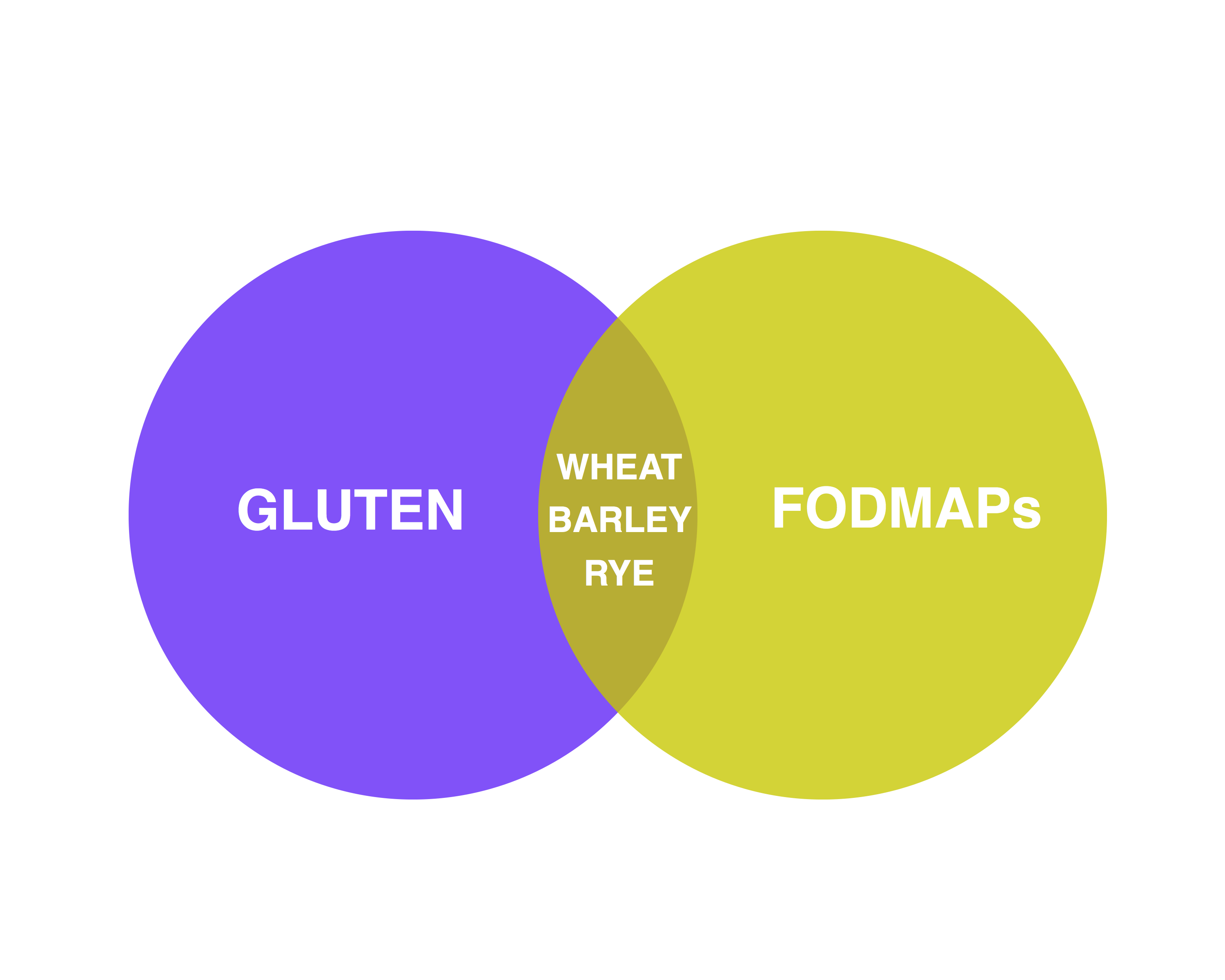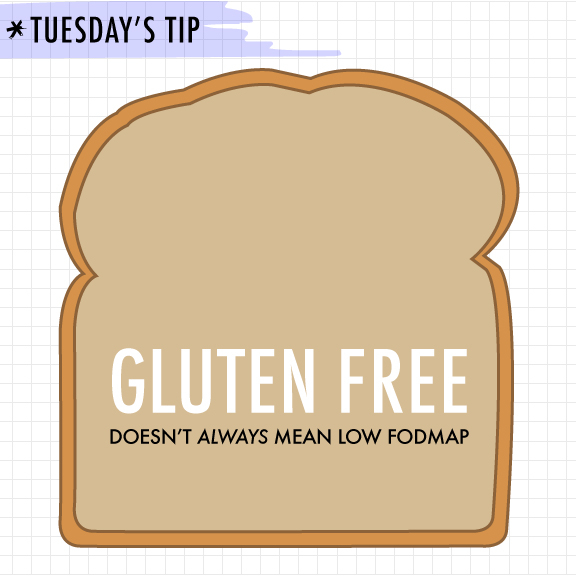Let’s start with the basics: FODMAPs are small carbohydrates (sugars and fibers) and gluten is a protein! So…the low FODMAP diet is one is which we are paying attention to carbohydrates…along with good nutrition, of course!
There is some overlap between a gluten free diet and a low FODMAP diet. Wheat, Barley and Rye contain both FODMAPs and gluten. But a low FODMAP diet is not necessarily a gluten free diet and a gluten free diet is NOT a low FODMAP diet.
 Choosing a gluten free bread will ensure the bread doesn’t have any wheat, barley and rye…..BUT it doesn’t ensure that other FODMAPs are NOT in the bread!
Choosing a gluten free bread will ensure the bread doesn’t have any wheat, barley and rye…..BUT it doesn’t ensure that other FODMAPs are NOT in the bread!
Common FODMAP ingredients found in some gluten free breads, cereals and other gluten free products include: honey, chicory root extract (inulin), soybean or other bean flours, apple or pear juice concentrate, dates, figs, and/or agave.
The low FODMAP diet is not a gluten free diet as traces of gluten found in foods are generally allowed on the low FODMAP diet. Examples of low FODMAP but NOT gluten free ingredients would be traditional soy sauce, which contains small amounts of wheat or wheat starch (a long chain carbohydrate–FODMAPs are small chain carbohydrates).
Yes, you will modify your gluten intake while you minimize wheat, barley and rye on the low FODMAP diet…but you might not completely restrict gluten unless you have celiac disease, non celiac gluten sensitivity or your health care provider has advised you to include the gluten free restriction as part of your nutrition plan.
So…remember choosing a gluten free item at the grocery store doesn’t automatically mean it will be suitable for your low FODMAP diet.
Always read ingredients.
And the winners of the Low-FODMAP 28-Day Plan are Susan R and Jen M! Congrats to both! And thanks for all the wonderful comments, as usual, you guys are the best! 🙂


Carol I-J
As always, Kate has the best posts about FODMAPs!
Phyllis S
How true! I was shocked when I checked out the “Gluten Free” products at a natural foods store, hoping to find a more basic ingredients list. They were just like the grocery store – many have a very long list of ingredients, many are not low FODMAPS or I don’t know what the ingredient is. I suspect they are there to add texture or flavor or whatever to make it more like the original item.
Brenda Bagley
I so enjoy your blog Kate. It’s full of great information and yummy recipes.
Thanks for all that you do!
Mary Ann Shaklan
Kate,
Your site is top notch! I have learned so much from you and have been on low fodmaps since the first of the year. Amazing difference in my life and activities. I am 75 and have had serious food issues for about 25 years. You have helped me more than any doctor. Thank you, thank you, thank you.
Wendy
I have been so surprised at the uproar about the articles saying that people my not be gluten sensitive they may have a FODMAP issue. That just floored me. This is a great post explaining what that.
I used to look for gluten free foods when I first found out I was allergic to wheat, I felt better avoiding all gluten. Then I really started avoiding most processed foods, but just couldn’t make good gluten free bread. I kept reading the ingredients on the packaging…oh my goodness the ingredients! What is some of that stuff! I found a few I would eat, but now I know I shouldn’t have been eating those because I’m sensitive to the seemingly innocent ingredients. Haha!
speaking of ingredients in breads….is tapioca low FODMAP?
katescarlata
I have not seen data on tapioca from the Monash team–but based on what I know–it is comprised on starch (longer chain carbs) not short chain carbs such as FODMAPs–so I allow it.
Wendy
thanks Kate,
Against the Grain makes these rolls that only have
Tapioca starch, milk, mozzarella cheese, eggs, non-GMO canola oil, salt.
in them.
I used to use them has burger buns, now and then.
a rare treat for sure.
but they are GOOD.
they also make a pizza crust…same ingredients.
They sure aren’t low in calories, but they are good…and I think pretty safe, and I can recognize all the ingredients. They remind me of Brazilian Cheese rolls.
Thanks again!!
wendy
Christine Gardner
The only bread that works for me is Spelt Sourdough, which is on the Monash low fodmap list.
Cara
I found I tolerate sprouted spelt bread with minimal ingredients.
Mickey
I was, still am to some degree on a low fodmap diet. When I was a kid bread products never bothered me. In the last ten years wheat based products has caused digestive issues and skin rashes. I tested negative for wheat alergies and celiac disease. I was listed as gluten sensitive. Even many gluten free products bothered me as well. My health was still going down hill and my doctors still did not know why.
So out of desperation, I went to a Hemotologist and had a lot of blood testing and the Hemotologist still was not sure what was causing my skin rashes and chronic fatigue. Then the Hemotologist ran some very expensive genetic testing as well.
They found it – Hereditary Hemochromatosis, my serum ferritin levels were above normal but not that high. I caught it time before great damage to my liver.
It was Enriched Flour with the artificial forms of iron (metal fillings) that was the key item ripping me apart. These artifical forms of iron are also found in many gluten free products also. I am one who is in tune with my body, I was a big tea drinker and into dairy products (yogurt and cheese – low fodmap foods items). Tannins In tea and calcium in dairy products block the absorbsion of natural forms of iron.
The good thing is , I can have my wheat bread again. The bad thing is since 99% of all commercial bread products use enriched flours. Now I have a nutrilmill wheat grinder and make my own flour and bake my own breads.
The treatment for Hemochromatosis is weekly, now monthly phlebotomies (bloodletting). My skin rashes are gone, energy levels are up and feeling much better. My digestive system is coming around to normal.
The bad part is I am spending half of my life cooking and baking in the kitchen. I am now on a low iron diet, no red meat (never ate much beef), no alcohol (never did binds with iron), no shellfish (was thought to be alergic to shellfish, it was high iron) and cut back on the sugar (binds with iron)
Still, the low fodmap diet did help. I wonder if a low fodmap diet a low iron diet?
katescarlata
Many of the gluten free grains do not receive the enrichment (added vitamins and minerals) that wheat flour receives–which includes added iron. So the low FODMAP diet could contain less iron for this reason.
Carol Benjamin
Thank you so much for this tip on ingredients. I do try to check but must work harder to get it right. I use UDI’s whole grain bread. Now I see there are ingredients that do not work for me. Thank you for your tips.
Jan
Hi Kate,
I have been been advised to try the low fodmap diet by my dietician at the hospital.
Sadly I’m really struggling to find lunch ideas to take to work with me.
I have recently been diagnosed with fructose intolerant via a hydrogen breath test but was found to be negative for lactose and glucose, so not all bad hey!
katescarlata
How about salad with grilled chicken, tuna or hard boiled eggs and a simple lemon and olive oil dressing or rice cakes with peanut butter and banana slices? Or leftover taco meat (season w/ chili powder w/o onion such as McCormick chipotle chili powder and cumin), chopped cherry tomatoes, cheddar in a taco shell?
Aurelia L.
I enjoy how you explain everything about the FODMAP diet in simple and understandable terms. It truly helps to use your information and guidance when trying to explain all of this to other people. I think that is still quite a challenge for myself, especially in my Italian family. Everyone does not always remember or completely understand, but it sure makes you grow in love and patience! =)
I noticed you mentioned occasionally some lactose-free products that are ‘okay’ for the diet…but, are there certain ingredients in ‘butters’ or ‘shortening’s’ that should be avoided? Just recently, Blue Bonnet Butter came out with Dairy Free butter sticks. However, I’m not sure if they are ‘safe’ for a Low FODMAP diet. Generally, I try to stick with the Crisco Shortening, but is that even safe? Here if the link to both if it helps!
http://www.bluebonnet.com/products/lactose-free-stick-margarine.jsp
http://www.crisco.com/products/all-vegetable-shortening-17-315
Thank’s again for your always insightful and helpful posts!
Blessings!
katescarlata
The low FODMAP diet is not a dairy free diet. See this post for more clarification: https://blog.katescarlata.com/2014/08/19/low-fodmap-dairy-free/
Jennifer Page
Is Flax Milk (Good Karma brand) ok? Thanks!
dkaj
Hi Kate, A couple questions for you: 1) Is wheat dextrin is considered a fermentable carbohydrate as one would find in benefiber?? 2) I’ve been reading about histamine intolerance and my dd does have reflux at times, even now with SIBO gone. She is getting reflux from the typical reflux foods and I have noticed that all of these traditional “reflux foods” are high in histamines. And, she has food intolerances per skin testing done by a board certified allergist/immunologist to peanuts, corn, shell fish, and brazil nuts. And, these are not considered your traditional reflux triggers, but are also higher histamines. So, my question is this. Is reflux more of a histamine issue overall where histamines are temporarily raising the acid levels in the gut?? My dd’s gastrin levels by blood were not elevated at all when we tested. That’s why I’m thinking this may be more sporatic related to food histamine reactions, but just my hypothesis once again. Wanted to get your take on this as she has had stomach reactions to the foods she tested positive to on skin tests. 3). Last question, you stated you were coming back to NE to do some additional speaking. By chance, would this trip be to do some formalized training with the dieticians here or medical professionals. I’m keeping my fingers crossed….. Any feedback would be awesome as always.
dkaj
Bump for Kate’s reply. TIA.